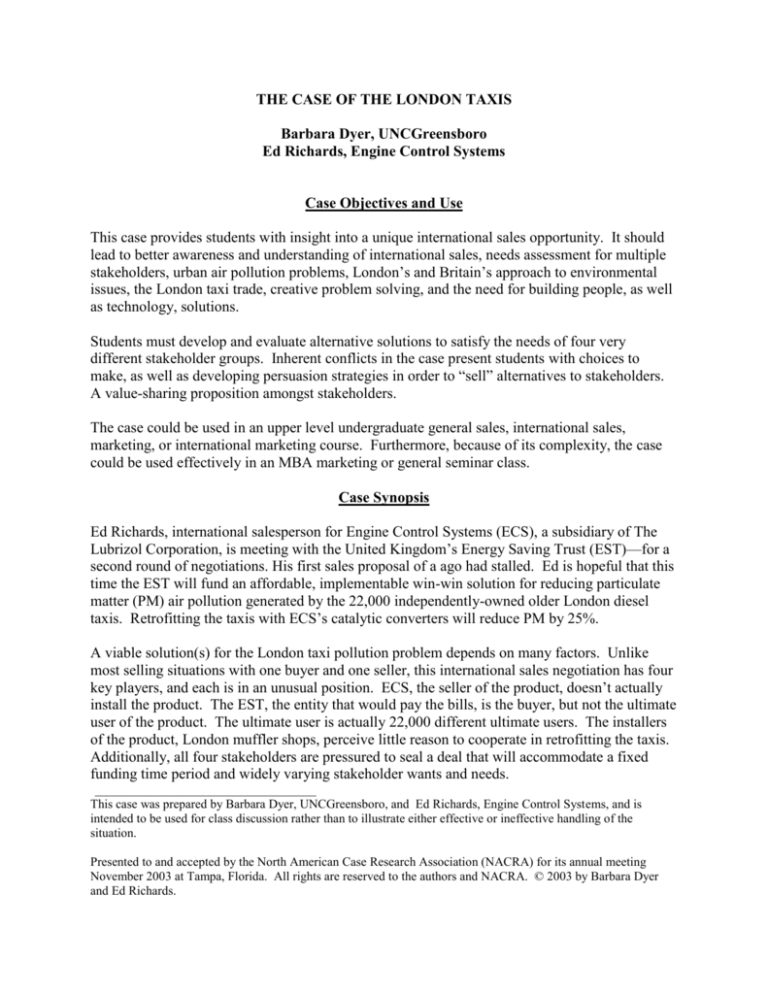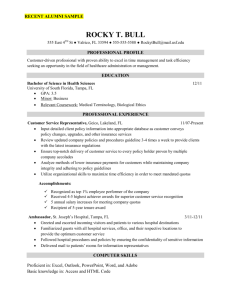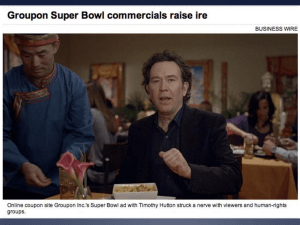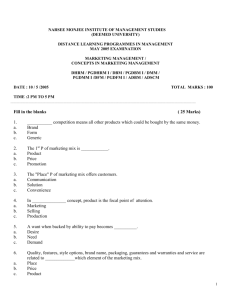
THE CASE OF THE LONDON TAXIS
Barbara Dyer, UNCGreensboro
Ed Richards, Engine Control Systems
Case Objectives and Use
This case provides students with insight into a unique international sales opportunity. It should
lead to better awareness and understanding of international sales, needs assessment for multiple
stakeholders, urban air pollution problems, London’s and Britain’s approach to environmental
issues, the London taxi trade, creative problem solving, and the need for building people, as well
as technology, solutions.
Students must develop and evaluate alternative solutions to satisfy the needs of four very
different stakeholder groups. Inherent conflicts in the case present students with choices to
make, as well as developing persuasion strategies in order to “sell” alternatives to stakeholders.
A value-sharing proposition amongst stakeholders.
The case could be used in an upper level undergraduate general sales, international sales,
marketing, or international marketing course. Furthermore, because of its complexity, the case
could be used effectively in an MBA marketing or general seminar class.
Case Synopsis
Ed Richards, international salesperson for Engine Control Systems (ECS), a subsidiary of The
Lubrizol Corporation, is meeting with the United Kingdom’s Energy Saving Trust (EST)—for a
second round of negotiations. His first sales proposal of a ago had stalled. Ed is hopeful that this
time the EST will fund an affordable, implementable win-win solution for reducing particulate
matter (PM) air pollution generated by the 22,000 independently-owned older London diesel
taxis. Retrofitting the taxis with ECS’s catalytic converters will reduce PM by 25%.
A viable solution(s) for the London taxi pollution problem depends on many factors. Unlike
most selling situations with one buyer and one seller, this international sales negotiation has four
key players, and each is in an unusual position. ECS, the seller of the product, doesn’t actually
install the product. The EST, the entity that would pay the bills, is the buyer, but not the ultimate
user of the product. The ultimate user is actually 22,000 different ultimate users. The installers
of the product, London muffler shops, perceive little reason to cooperate in retrofitting the taxis.
Additionally, all four stakeholders are pressured to seal a deal that will accommodate a fixed
funding time period and widely varying stakeholder wants and needs.
___________________________________
This case was prepared by Barbara Dyer, UNCGreensboro, and Ed Richards, Engine Control Systems, and is
intended to be used for class discussion rather than to illustrate either effective or ineffective handling of the
situation.
Presented to and accepted by the North American Case Research Association (NACRA) for its annual meeting
November 2003 at Tampa, Florida. All rights are reserved to the authors and NACRA. © 2003 by Barbara Dyer
and Ed Richards.
WALWORTH ORCHARDS (INDIA) LTD: MARKETING A NEW CONCEPT
M. Janakiraman, Indian Institute of Management
P. Venugopal, XLRI
Case Objectives and Use
This case brings out issues, problems, and means of designing a new service offer. Students can
generate feasible alternatives and understand the problems and opportunities in selling a new
concept. The case will help students to go through marketing strategy formulation process with
limited information, and also help them in generating appropriate information required for
initiating any market research. Participants can compare existing investment offers in the market
and develop competitive positioning of product and further develop a compelling value
proposition.
Teaching note is written with the objective of using the case for graduate courses such as
Marketing Management, Product Management, and Executive Development Programs like
Marketing Financial Services. Participants may require prior understanding of investment
product offers. If they don’t have, instructor can provide short supplementary notes or start the
session with a brief lecture.
Case Synopsis
Govind, General Manager of Marketing of Walworth Orchards (India) Limited (WOL), was
contemplating various options of presenting agricultural income as investment option to
customers. WOL was established with the objective of promoting agricultural wealth by bringing
vast stretches of fallow lands in India under cultivation. About 240M acres of cultivable land was
lying fallow due to lack of resources and technology. WOL business model included acquiring
and converting fallow land into high yielding fruit orchards and selling small plots of land as
investment proposition. Walworth proposed to cultivate and maintain orchards using latest
international cultivation, harvesting and post-harvesting technology. Profit from the sale of
produce was to be returned to investors. The benefits for the investor were expected to come
from the advanced farming technology resulting in higher yields and higher price realization
through better marketing, and from land value appreciation. However, the business model was
yet to be proven and there were no precedence of such an offer in the market. The case deals
with the options that Govind had for developing marketing strategy for a new concept,
specifically it would require defining product offer, and developing competitive positioning the
offer as an attractive investment proposition to the prospective customers.
___________________________________
This case was prepared by Moorthy Janakiraman, Indian Institute of Management, Lucknow, India, and Pingali
Venugopal, XLRI Jamshedpur, India, and is intended to be used for class discussion rather than to illustrate either
effective or ineffective handling of the situation.
Presented to and accepted by the North American Case Research Association (NACRA) for its annual meeting,
November 2003, Tampa, Florida. All rights reserved to the authors and NACRA. © 2003 by M. Janakiraman and
P. Venugopal.
THE SPRINGFIELD IRON HORSE TRIATHLON
Paul K. McDevitt, University of Illinois at Springfield
Case Objectives and Use
This is a case about a segment of the event management industry with which many students are
familiar and in which many are interested: sports marketing. The case involves analysis,
planning and decision-making for an annual sporting event. The race director is trying to make
important product and price decisions without little clear strategic guidance. The case portrays a
classic situation where the absence of a clearly articulated positioning strategy suddenly becomes
problematic as a major competitor apparently repositions aggressively in the market. The matter
of “ How shall we respond?” depends upon “What we wish to be.” The absence of strategic
guidance “backs” students into confronting the need to agree upon a clear positioning strategy
and then resolving tactical product and pricing issues.
The teaching note was prepared for undergraduate students enrolled in advanced marketing
electives such as marketing management, sports marketing or services marketing. Detailed data
are available enabling (forcing) students to prepare historical and pro forma income and cash
flow statements and/or to conduct break-even analyses.
Case Synopsis
David Johnson, the race director, is pulling together his records and evaluating the outcome of
the 2002 event while preparing to begin the planning cycle for 2003. We share his thoughts as
he updates his financial records and begins thinking about specifics for next year. Three
interrelated, tactical decisions relating to price/value must be made soon. First, can he afford two
event upgrades in 2003? Second, can he achieve two financial objectives next year: restore the
race’s depleted financial reserve and make a larger contribution to a community charity? Third,
must/should he consider raising his fee structure?
The external environment includes a clearly profiled customer base, a favorable growth market
and a competitor-initiated challenge to the future of Iron Horse.
___________________________________
This case was prepared by Paul K. McDevitt, University of Illinois at Springfield, and is intended to be used for
class discussion rather than to illustrate either effective or ineffective handling of the situation.
Presented to and accepted by the North American Case Research Association (NACRA) for its annual meeting,
November 2003, Tampa, Florida. All rights reserved to the author and NACRA. © 2003 by Paul K. McDevitt.
HEALTHTEX AND WAL-MART: A GOOD PARTNERSHIP?
Kristina Eisele, Martha McEnally & Anna Woitalla
University of North Carolina at Greensboro
Case Objectives and Use
This case offers students an opportunity to develop retail strategy for a well-known brand of
children’s playwear whose market share has been declining. Once a well-known brand with
widespread department store distribution, Healthtex’s market share has continued to shrink as it
loses more department store replacements. To determine how the company might reposition
itself and rebuild share, students must evaluate the competitive climate, consumer segments as
well as considering the company’s internal climate, history and positioning.
This case could be used in a retailing course, a marketing management course at the
undergraduate level or an introductory marketing course at the graduate level. It provides the
instructor with an ideal platform for discussing how the element of distribution can impact brand
reputation and overall positioning.
Case Synopsis
Healthtex has long been a well-known brand in the children’s clothing market. Little John-John
Kennedy wore Healthtex outfits! In the last quarter of twentieth century, the Standard Romper
Company, originator of Healthtex, was bought by Cheesebrough-Ponds and later by VF
Corporation – a company whose strategy is to buy languishing brands and resuscitate them.
In this period, Healthtex focused on product development, developing many new products
features for its Kidmatch, Kidproof and Kidstretch innovations, but these have not been enough
to save the brand. It continues to experience retail placement loss.
Thus, management at Healthtex is considering changing the distribution strategy from all
department store (and some internet) placement to include discount placement at Wal-Mart under
the brand name Kids Edition by Healthtex. Their goal would be to generate volume by
leveraging off their brand name. Management, however, realizes that this change can lose them
both retail accounts and final consumer sales. The case presents information about the market
and Wal-Mart for students to make a decision.
___________________________________
This case was prepared by Kristina Eisele, Martha McEnally, and Anna Woitalla, University of North Carolina at
Greensboro, and is intended to be used for class discussion rather than to illustrate either effective or ineffective
handling of the situation.
Presented to and accepted by the North American Case Association (NACRA) for its annual meeting in November
2003 at Tampa, Florida. All rights are reserved to the authors and NACRA. © 2003 by Kristina Eisele, Martha
McEnally, and Anna Woitalla.
SHOPPING WITH EWA: POLISH CONSUMER BEHAVIOR
Susan D. Peters, California State Polytechnic University at Pomona
Case Objectives and Use
The best fit for this case is in a Consumer Behavior course; it allows the student to focus on a
variety of consumer responses and behaviors – reactions to advertisements, brand
awareness/equity, customer service expectations, shopping behavior, and complaint behavior. It
can also be used in a Principles of Marketing or Introduction to Global Business class to
illustrate basic differences between US cultural values and those of Poland (and to some degree
other command and recently converted countries). It has also been used successfully at the
master’s level as a catalyst for a more in-depth investigation of difference between Polish and
US consumer behavior.
Depending on the course in which the instructor uses the case, objectives include illustrating the
differences in consumer behavior between a typical US consumer and a Polish consumer,
investigating political, economic, political, and historical environments and there impact on
consumer behavior, investigating customer service and consumer quality expectations in a nonUS setting, and exploring ethical implications for a Western business choosing to do business
there.
Case Synopsis
The case takes place in the mid 1990’s and centers around a day of shopping between two
friends – Ewa, a mid-twenties Polish professional woman, and Katie, a middle-aged recent
expatriate to Poland. Throughout the day, Katie and Ewa brush up against each other’s cultural
values and expectations.
At this point in time, Poland had enjoyed several years of freedom from Soviet influence and a
burgeoning market economy was forming. The development of this market economy was
hampered, not so much by legal and economic issue, as the infinitesimal cultural change. In this
regard, the Poles were their own worst enemy, outwardly embracing the change, but still clinging
to their “command economy” mindsets.
___________________________________
This case was prepared by Susan D. Peters, California State Polytechnic University at Pomona, and is intended to be
used for class discussion rather than to illustrate either effective or ineffective handling of the situation.
Presented to and accepted by the North American Case Research Association (NACRA) for its annual meeting,
November 2003, Tampa, Florida. All rights reserved to the author and NACRA. © 2003 by Susan D. Peters.
HEART RESTAURANTS: THE SHOCK DECISION
Donald E. Saunders, Miami University
Case Objectives and Use
This case includes complexities in the development of market driven, business-to-business,
supply chain relationships. Superior supply service by foodservice distributors is a core
requirement for successful restaurant operation. Issues faced by HEART Restaurants
management in the development and execution of a successful chain-wide supply strategy are at
the heart of the HEART case.
The case provides learning opportunities in corporate/supply chain strategy alignment and
implementation. Instructors may address Porter analysis, industry analysis, industry
segmentation, buyer-seller connections, sales force/customer relationships, and issues arising
from managing a core service requirement.
Case use: Marketing Management, Business-to-Business Marketing, Supply Chain Management,
and Marketing Strategy courses at senior undergraduate and MBA levels.
Case Synopsis
Wilson Rice, vice president for purchasing, was faced with an urgent, complex strategic
purchasing decision. HEART Restaurants had been “offered” a 29 percent cost increase ($2.0
million annually) for the supply of its foodservice distribution services by a new parent company
of HEART’s long-time supply services partner. The new parent company (Prince Holdings) had
proposed this radical cost increase to HEART management (and Wilson Rice) without prior
warning. Immediately, Rice had undertaken a search for supply service alternatives. His
thorough, well-researched investigation produced an unusual supply system option, one that
could generate an improved cost picture with some new, supplier-performance risks.
The HEART Restaurants corporate growth strategy, coupled with U S industry dynamics in
foodservice supply services, provided tension in the case. Further complicating this supply
services situation was the desire by HEART for long-term supply partnerships. There appeared
to be no solution available that fully incorporated the selected corporate growth strategy, an
ensured supply service, and a business partnership. Rice had been about to sign new supply
contracts for his unusual alternate system when he received an 11th hour proposal from supplier
Prince Holdings: it would “meet or beat” any competitive offer. Students are left with the
decision challenge that confronted Rice.
___________________________________
This case was prepared by Donald E. Saunders of Miami University and is intended to be used for class discussion
rather than to illustrate either effective or ineffective handling of the situation.
Presented to and accepted by the North American Case Research Association (NACRA) for its annual meeting,
November 2003, Tampa, Florida. All rights reserved to the author and NACRA. © 2003 by Donald Saunders.
KITCHENAID’S NEW SUPERPREMIUM PRODUCT LINE:
DESIGNING THE PURCHASE EXPERIENCE
Lauren Oliver Strach, Andrews University
Vikas Sharma, Whirlpool Corporation
Case Objectives and Use
This case provides an example of a well-known market leader in a mature, durable goods market,
entering a new niche market, and the challenges that go with creating a positioning strategy. The
case discusses the marketing strategy of KitchenAid brand’s new super-premium line of
appliances. Particular emphasis is given to creating a purchase experience that will set the new
brand apart from the existing and well-established competition. The creation of this strategy
examines each of the touch points of the purchase experience and how to reach the Home
Enthusiast target market through each of these opportunities.
Based on extensive field research at Whirlpool Corporation, this case was written primarily as a
case for an undergraduate or graduate Marketing Management course. Additional uses would be
for courses on New Product Development or Buyer Behavior.
Case Synopsis
In an attempt to diversify in a mature market, Whirlpool Corporation’s KitchenAid brand
developed a new super-premium line of appliances. As the launch date draws near the work on a
differentiating marketing strategy is getting more intense. Research identified the Home
Enthusiast as the target consumer. Home Enthusiasts were people whose lives were centered on
their homes and everything that goes on there. This market was a totally new market for
KitchenAid, and it was a market with several existing successful brands. KitchenAid’s
positioning goal was to differentiate the product by creating a “beyond product, white glove”
experience through all the consumer touch points, including, potentially, a post-purchase
relationship to reinforce customer loyalty. KitchenAid benchmarked companies in other
industries that were well known for creating this type of added value purchase experience,
companies such as Lexus, Nordstrom’s and American Express. Their challenge was to translate
that type of service into the appliance industry, to evaluate the relevant touch points before,
during and after the purchase of the suite of appliances and to create the type of experience that
would result, not only in the purchase of the appliance suites, but in developing a strong sense of
ongoing brand loyalty.
___________________________________
This case was prepared by Lauren Oliver Strach, Andrews University, and Vikas Sharma, Whirlpool Corporation,
and is intended to be used for class discussion rather than to illustrate either effective or ineffective handling of the
situation.
Presented to and accepted by the North American Case Research Association (NACRA) for its annual meeting,
November 2003, Tampa, Florida. All rights reserved to the authors and NACRA. © 2003 by Lauren Strach and
Vikas Sharma.
LATIN ENTERTAINMENT NETWORK: ADAPT OR DIE?
Mary L. Wood, Kimberly Mesa & Erika Matulich (faculty supervisor)
University of Tampa
Case Objectives and Use
This case presents the challenges a start-up company can experience when marketing its products
or services amid increasing competition. Through analysis, students are asked to develop
alternative solutions to the internal problems a company encounters with respect to a variety of
external environmental challenges. Students are further asked to examine the company’s market
position, target market, investment potential, and future success in the Hispanic media market.
Case Synopsis
Latin Entertainment Network (LEN) is a Hispanic media broadcast company that distributes a
popular format called Vibra Hits. The greatest challenge to the LEN has been the continued
marketing of Vibra Hits to radio stations in a growing market of increased competition.
Vibra Hits is a twenty-four hour a day, seven day a week blend of Mexican music and
contemporary Spanish pop music and was carried by thirty stations across the country, managed
by LEN. In the months following the introduction, the radio stations had stopped
communicating with LEN and new competition had entered the market. Over time, the quality
of the show, which was produced by a third party, began to diminish, engineering difficulties in
the satellite led to downtime, and re-runs were being broadcast on the network of thirty stations,
without the knowledge of LEN. This angered radio station programmers eventually leading to
the withdraw of their contracts with LEN. In response to the frustration experienced by the
station programmers, the competition picked up these stations and contracted deals to run their
own network programming. In addition to the loss of the thirty stations, externally, LEN faced a
nervous economy, declining confidence in the stock market, apprehensive investors, and easy
entry into the market by competitors.
In summary, the CEO of LEN is faced with a strategic marketing dilemma. Should they
continue to support the format by re-signing the stations, develop a new network of stations, or
drop the format and focus on other opportunities? The company’s reputation is on the line and
the management team needs to take careful, calculated, and quick action to satisfy the needs and
wants to the growing Hispanic market, before the competitors do.
___________________________________
This case was prepared by Mary L. Wood, Kimberly Mesa, and Erika Matulich (faculty supervisor), University of
Tampa, and is intended to be used for class discussion rather than to illustrate either effective or ineffective handling
of the situation.
Presented to and accepted by the North American Case Research Association (NACRA) for its annual meeting,
November 2003, Tampa, Florida. All rights reserved to the authors and NACRA. © 2003 by Mary L. Wood and
Kimberly Mesa.









